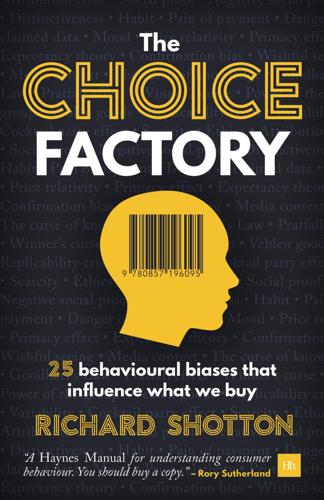
The Choice Factory: 25 Behavioural Biases That Influence What We Buy
by
Richard Shotton
Published 12 Feb 2018
Contentsx Praise for The Choice Factory Preface Introduction Bias 1: The Fundamental Attribution Error Bias 2: Social Proof Bias 3: Negative Social Proof Bias 4: Distinctiveness Bias 5: Habit Bias 6: The Pain of Payment Bias 7: The Danger of Claimed Data Bias 8: Mood Bias 9: Price Relativity Bias 10: Primacy Effect Bias 11: Expectancy Theory Bias 12: Confirmation Bias Bias 13: Overconfidence Bias 14: Wishful Seeing Bias 15: Media Context Bias 16: The Curse of Knowledge Bias 17: Goodhart’s Law Bias 18: The Pratfall Effect Bias 19: Winner’s Curse Bias 20: The Power of the Group Bias 21: Veblen Goods Bias 22: The Replicability Crisis Bias 23: Variability Bias 24: Cocktail Party Effect Bias 25: Scarcity Ethics Conclusion References Further reading Acknowledgements Index Praise for The Choice Factory “This book is a Haynes Manual for understanding consumer behaviour. You should buy a copy - and then buy another copy to give to one of the 97% of people in marketing who are too young to remember what a bloody Haynes Manual is.” — Rory Sutherland, columnist for The Spectator, and Executive Creative Director, Ogilvy One “Most books in this area are academic and dry as dust. If you want to know how research and sociology can impact on real life in the real world, Richard’s book will show you - using simple words and examples that real people can understand
…
I’d finished studying at Oxford University half a dozen years earlier and since then I’d ignored academia on the assumption that research was irrelevant to the hard nosed, commercial world of advertising. But I was mistaken. What could be more relevant to advertising – which aims to change the decisions of consumers – than a study of the roots of decision-making? As Rory Sutherland, Vice Chairman, Ogilvy & Mather Group, says: This subject provides a robust, intellectual link between understanding human nature and knowing how to make money. In the same way that you wouldn’t trust a doctor with no knowledge of physiology or an engineer ignorant of physics, my experience over the last dozen or so years suggests that it’s foolhardy to work with an advertiser who knows nothing of behavioural science.
…
But that £34 figure equates to 7p per gram, exactly what they’re charging now. The value of switching comparison sets for Nespresso has been stratospheric. A Bloomberg article estimated their 2015 total annual sales at $4.5bn. Nespresso is not a one-off. Think about how Red Bull manages to charge such a price premium over other soft drinks. Rory Sutherland, vice Chairman of the Ogilvy & Mather group, says: How can Red Bull charge £1.50 a can when Coke only charge 50p? Weirdly you make the can smaller. Suddenly people think this is a different category of drink for which different price points apply. If the can had been the same size, I am not sure they could have charged £1.50.
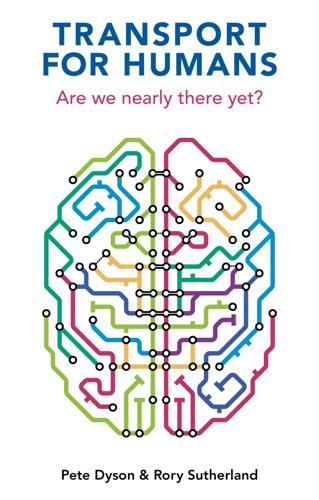
Transport for Humans: Are We Nearly There Yet?
by
Pete Dyson
and
Rory Sutherland
Published 15 Jan 2021
— Christian Wolmar Digital Transformation at Scale: Why the Strategy Is Delivery — Andrew Greenway, Ben Terrett, Mike Bracken and Tom Loosemore Gaming Trade: Win–Win Strategies for the Digital Era — Rebecca Harding and Jack Harding The Currency Cold War: Cash and Cryptography, Hash Rates and Hegemony — David Birch Catastrophe and Systemic Change: Learning from the Grenfell Tower Fire and Other Disasters — Gill Kernick Transport for Humans: Are We Nearly There Yet? — Pete Dyson and Rory Sutherland Transport for Humans Are We Nearly There Yet? Pete Dyson Rory Sutherland london publishing partnership Copyright © 2021 Pete Dyson and Rory Sutherland Published by London Publishing Partnership www.londonpublishingpartnership.co.uk Published in association with Enlightenment Economics www.enlightenmenteconomics.com All Rights Reserved ISBN: 978-1-913019-35-8 (pbk) ISBN: 978-1-913019-36-5 (iPDF) ISBN: 978-1-913019-37-2 (epub) A catalogue record for this book is available from the British Library This book has been composed in Candara Copy-edited and typeset by T&T Productions Ltd, London www.tandtproductions.com Preface This book started from observing simple frustrations with the way we get around.
…
This goes beyond human choice. The effect was predicted computationally by German mathematician Dietrich Braess in 1968 for electrical circuits and biological systems. More is not always faster. 3 R. Sutherland. 2009. Life lessons from an ad man. TED Talk, July (www.ted.com/talks/rory_sutherland_life_lessons_from_an_ad_man). 4 This is known as the ‘Triple Access System’ and is explained in G. Lyons and C. Davidson. 2016. Guidance for transport planning and policymaking in the face of an uncertain future. Transportation Research Part A: Policy and Practice 88, 104–116. Figure 5.
…
Carsharing with shared autonomous vehicles: uncovering drivers, barriers and future developments – a four-stage Delphi study. Technological Forecasting and Social Change 144, 66–81. Chapter 14 Rebalancing the equation The human mind does not run on logic any more than a horse runs on petrol. — Rory Sutherland in Alchemy (2019) Behavioural science provides a valuable counterpoint to the historically dominant view of transport as a logical, quantifiable battle for efficiency gains in a competitive space. Without some acknowledgement of human psychology and epistemology and without understanding the need for framing and storytelling, you can be as logical as you like and still fail.
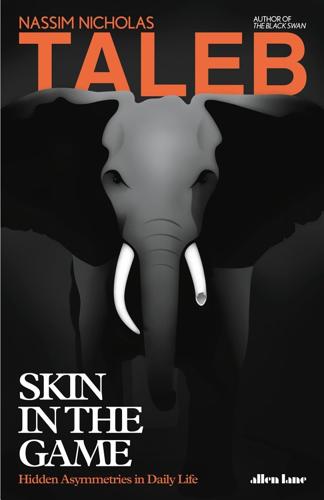
Skin in the Game: Hidden Asymmetries in Daily Life
by
Nassim Nicholas Taleb
Published 20 Feb 2018
Galam’s models produced a bevy of counterintuitive effects in political science—and his predictions have turned out to be way closer to real outcomes than the naive consensus. THE VETO What we saw in the renormalization group was the “veto” effect, as a person in a group can steer choices. The advertising executive (and extremely bon vivant) Rory Sutherland suggested to me that this explains why some fast-food chains, such as McDonald’s, thrive. It’s not because they offer a great product, but because they are not vetoed in a certain socio-economic group—and by a small proportion of people in that group at that.fn1 When there are few choices, McDonald’s appears to be a safe bet.
…
NEXT This chapter will ease us to the next section: a) rationality resides in what you do, not in what you think or in what you “believe” (skin in the game), and b) rationality is about survival. Book 8 * * * RISK AND RATIONALITY Chapter 18 How to Be Rational About Rationality Restaurants without kitchens—Science from the grave—Do not shoot to the left of piano players—Merchants of rationality My friend Rory Sutherland claims that the real function of swimming pools is to allow the middle class to sit around in bathing suits without looking ridiculous. Same with New York restaurants: you think their mission is to feed people, but that’s not what they are about. They are in the business of overcharging you for liquor or Great Tuscan wines by the glass, yet get you in the door by serving you your low-carb (or low-something) dishes at break-even cost.
…
I once received a letter from a person from the finance industry with the following request: “Dear Mr. Taleb, I am a close follower of your work, but I feel compelled to give you a piece of advice. An intellectual like you would greatly gain in influence if he avoided using foul language.” My answer was very short: “f*** off.” fn5 My friend Rory Sutherland (the same Rory) explained that some more intelligent corporate representatives had the strategy of cursing while talking to journalists in a way to signal that they were conveying the truth, not reciting some company mantra. fn6 Universal suffrage did not change the story by much: until recently, the pool of elected people in so-called democracies was limited to a club of upper class people who cared much, much less about the press.
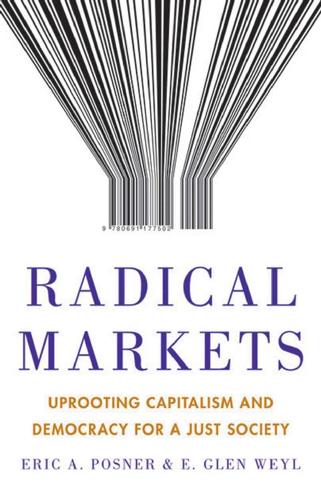
Radical Markets: Uprooting Capitalism and Democracy for a Just Society
by
Eric Posner
and
E. Weyl
Published 14 May 2018
Does a person who “very strongly” opposes abortion rights mean that she will vote against any candidate who supports those rights, or just that it is one among many factors that she will take into account? FIGURE 2.2: Frequency of participants’ expression positions ranging from strong disagreement to strong agreement with a national ban on abortion in the United States. Source: Adapted from David Quarfoot, Douglas von Kohorn, Kevin Slavin, Rory Sutherland, David Goldstein, & Ellen Konar, Quadratic Voting in the Wild: Real People, Real Votes, 172 Pub. Choice 283 (2017), p. 6. QV offers a solution to this problem. Rather than allowing respondents to freely express any position they wish, a poll based on QV endows each participant with a budget of voice credits and allows her to spend the credits on the range of issues available as she wishes.
…
QV shows, for example, the greater intensity of preferences for repealing Obamacare, compared to those for retaining it, which helped fuel the success of Republicans in the 2016 election. FIGURE 2.4: Participant opinions on Obamacare under a standard Likert (left) and QV (right) survey. “Vote strength” in both graphs represents degree of support (on left) or opposition (on right) for Obamacare. Source: Adapted from David Quarfoot, Douglas von Kohorn, Kevin Slavin, Rory Sutherland, David Goldstein, & Ellen Konar, Quadratic Voting in the Wild: Real People, Real Votes, 172 Pub. Choice 283 (2017), p. 6. A nice illustration of this second point is figure 2.5, which shows the voting patterns for two different voters who expressed the most extreme preference on almost every issue under Likert.
…
Rensis Likert, A Technique for the Measurement of Attitudes, in Archives of Philosophy No. 140, 5–55 (R. S. Woodworth, ed., 1932). 42. Sendhil Mullainathan & Eldar Shafir, Scarcity: The New Science of Having Less and How It Defines Our Lives (Picador, 2014). 43. David Quarfoot, Douglas von Kohorn, Kevin Slavin, Rory Sutherland, David Goldstein, & Ellen Konar, Quadratic Voting in the Wild: Real People, Real Votes, 172 Public Choice 283 (2017). 44. There is still one anomaly in the QV distribution: a dip at 0. This results from a weakness in the weDesign software: we only allow “whole” votes on issues. This may make it impossible to vote a bit more on something you are passionate about once you have already put several votes on this issue, because you may only have a few credits left.
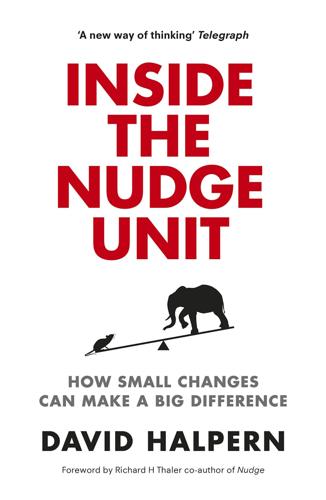
Inside the Nudge Unit: How Small Changes Can Make a Big Difference
by
David Halpern
Published 26 Aug 2015
If the Nudge Unit was to survive in the vortex of No. 10, it had to offer advice and solutions to the PM and other Ministers that was distinctive, and value adding, from all the other advice that poured in through the myriad meetings and river of paper that flows across Whitehall and into the PM’s red box. The curious case of electronic cigarettes Rory Sutherland is a larger than life character. He’s one of those people who positively embraces eccentricity and, with a twinkle in his eye, seeks to push a story or an idea to the point where you’re not really sure if he’s serious. In organisational psychology, he’s what is sometimes called a ‘plant’ – a person you deliberately keep around to produce crazy ideas.
…
I do not know if they ran it as a systematic trial. The last bit, about ‘threatening’ to send it, was shameless embellishment. Chapter 1: Early Steps 1 One of the most basic psychological effects is how familiarity breeds liking, from random sequences of notes to how much we like and trust institutions. 2 I’m grateful to Rory Sutherland for first drawing my attention to the fascinating example of how Frederick the Great encouraged Prussians to adopt the potato. 3 Quoted in Quarterly Journal of Military History, August 2009. 4 UCLA Department of Epidemiology, School of Public Health; http://www.ph.ucla.edu/epi/snow/victoria.html. 5 The Rotherhithe Tunnel was opened around 1908, and today carries the A101 road from Limehouse to Rotherhithe.
…
The team and I are also indebted to the work and counsel of many others, especially to Daniel Kahneman and Cass Sunstein; and also David Albury, Dan Ariely, Jon Baron, Christian Bason, Maurice Biriotti, John Britton, Iris Bohnet, Max Bazerman, Bob Cialdini, Cary Cooper, Angus Deaton, Paul Dolan, Angela Duckworth, Bobby Duffy, Carol Dweck, Gerd Gigerenzer, Ben Goldacre, Pelle Hanson, Tim Hartford, John Helliwell, Felicia Huppert, Paul Johnson, Mike Kelly, Beau Kilmer, Dom King, Christian Kroll, David Laibson, Richard Layard, Steve Levitt, John List, Donald Low, Mike Luca, Robert McCorquodale, Mike Norton, Beth Novack, Philip Oreopoulos, Ben Page, Bob Putnam, Matt Rabin, Todd Rogers, Marty Seligman, Nigel Shadbolt, Eldar Shafir, Jonathan Shepherd, Dilip Soman, Rory Sutherland, Richard Suzman, Larry Sherman, Andrew Skates and Kevin Volpe. Most of all, I would like to thank the wonderful and talented people who make up and support the Behavioural Insights Team itself. A particular thanks is due to Owain Service, who has been central to building a cohesive team and navigating the complexities of moving from inside government to the current form, and to Andy Jackson and Olly Nguyen to delivering a functioning organisation.
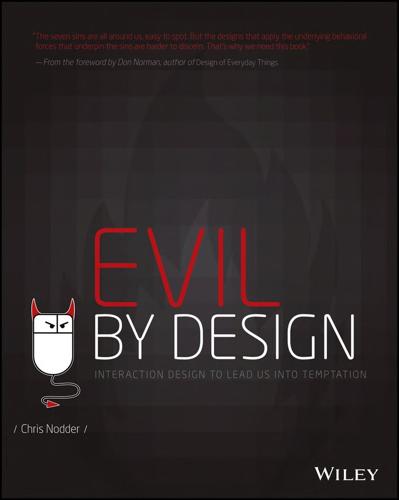
Evil by Design: Interaction Design to Lead Us Into Temptation
by
Chris Nodder
Published 4 Jun 2013
The intangible value isn’t inherent in the materials used, or necessarily in the time and care taken to create the object. Instead the intangible value is assigned by our perceptions of and relationship with the object. It’s the emotional aspect of this intangible part of the value equation that generates lust. Rory Sutherland, the executive creative director at Oglivy & Mather UK, suggests that most value-related problems are problems of perception rather than function, and so it’s often much more productive to tinker with perceptions rather than reality. Disney theme parks, for instance, just don’t have sufficient space on their rides to seat every visitor at the same time.
…
Instagram terms of service: Bryan Bishop. “Instagram's new terms of service: from overreaction to retraction.” The Verge (verge.com). December 20, 2012. Retrieved March 2013. Chad’s garage comic: “Instagram” © Randall Munroe, xkcd.com. Sell the intangible value Goldhut photo credit: Chris Nodder. Problems of perception: Rory Sutherland “Perspective is everything” Ted talk, (ted.com). Make a request in order to be seen more favorably Benjamin Franklin quote: The Autobiography of Benjamin Franklin. Boston: Houghton Mifflin & Co., 1906. p. 107. Return the money you won: Jon Jecker and David Landy. “Liking a person as a function of doing him a favour.”
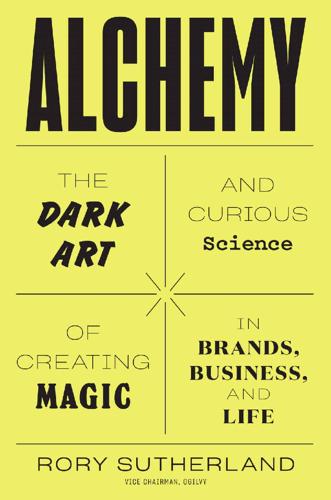
Alchemy: The Dark Art and Curious Science of Creating Magic in Brands, Business, and Life
by
Rory Sutherland
Published 6 May 2019
‘. . . for leather car seats than for books on tape.”, Daniel Kahneman, ‘Focusing Illusion’, Edge (2011). About the Author RORY SUTHERLAND is vice chairman of Ogilvy. A columnist for The Spectator, he is former president of the Institute of Practitioners in Advertising, the professional body for advertising, media, and marketing communications agencies in the United Kingdom. His TED Talks have been viewed more than 6.5 million times. He lives in London. Discover great authors, exclusive offers, and more at hc.com. Copyright ALCHEMY. Copyright © 2019 by Rory Sutherland. All rights reserved under International and Pan-American Copyright Conventions.
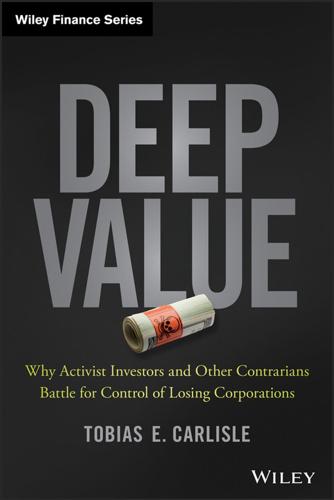
Deep Value
by
Tobias E. Carlisle
Published 19 Aug 2014
Meehl’s practical conclusion is this: For a very wide range of prediction problems, statistical prediction rules—often very simple models—make predictions that are at least as reliable as, and typically more reliable than, human experts. This observation is now so well-accepted as to be known as The Golden Rule of Predictive Modeling.64 Rory Sutherland, the vice-chairman of Ogilvy Group UK—the advertising agency founded by David Ogilvy, who was an early advocate of quantification and research in advertising—is a self-described champion of the application of behavioral economics in advertising. Sutherland believes that we are more likely to follow simple, absolute rules—“if X, then Y”—that work 142 DEEP VALUE with our nature than others that are subtle, and require a “continuous exercise of self-restraint:”65 Let’s consider the old rule of restricting yourself to a maximum number of units of alcohol a week.
…
Available at SSRN: http://ssrn.com/abstract=2042657 or http://dx.doi. org/10.2139/ssrn.2042657. Ibid. Catch a Falling Knife 149 63. Michael A. Bishop and J. D. Trout. “50 years of successful predictive modeling should be enough: Lessons for philosophy of science.” Philosophy of Science 69.S3 (2002): S197–S208. 64. Ibid. 65. Rory Sutherland. “The Wiki Man: If you want to diet, I’m afraid you really do need one weird rule.” The Spectator, April 13, 2013. 66. Benjamin Graham. “A Conversation with Benjamin Graham.” Financial Analysts Journal, Vol. 32, No. 5 (1976), pp. 20–23. 67. Bishop and Trout, 2002. 68. Ibid. 69. Benjamin Graham and David Dodd.
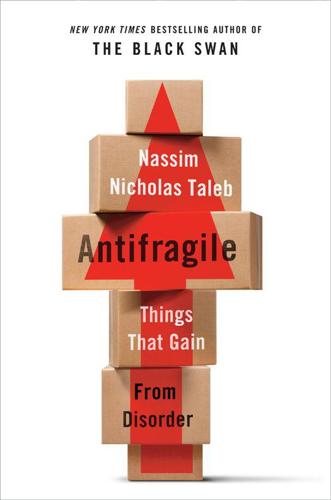
Antifragile: Things That Gain From Disorder
by
Nassim Nicholas Taleb
Published 27 Nov 2012
I don’t mean provide him with a bad doctor: just pay for him to choose his own. Any doctor will do. This may be the only possible way to murder someone while staying squarely within the law. We can see from the tonsillectomy story that access to data increases intervention, causing us to behave like the neurotic fellow. Rory Sutherland signaled to me that someone with a personal doctor on staff should be particularly vulnerable to naive interventionism, hence iatrogenics; doctors need to justify their salaries and prove to themselves that they have a modicum of work ethic, something that “doing nothing” doesn’t satisfy. Indeed, Michael Jackson’s personal doctor has been sued for something equivalent to overintervention-to-stifle-antifragility (but it will take the law courts a while to become directly familiar with the concept).
…
Anything that removes the risk of ruin will get us to such a barbell. The legendary investor Ray Dalio has a rule for someone making speculative bets: “Make sure that the probability of the unacceptable (i.e., the risk of ruin) is nil.” Such a rule gets one straight to the barbell.3 Another idea from Rory Sutherland: the U.K. guidelines for patients with mild problems coming from alcohol are to reduce the daily consumption to under a certain number of grams of alcohol per day. But the optimal policy is to avoid alcohol three times a week (hence give the liver a lengthy vacation) then drink liberally the remaining four.
…
Acknowledgments Peter Bevelin, Jazi Zilber, Peter Tanous, and Rolf Dobelli read the entire manuscript several times in several different versions in great detail and provided generous comments or hints on relevant research. I had exceptional and enthusiastic contributions from Will Murphy, Evan Camfield, Alexis Kirshbaum, Cynthia Taleb, Will Goodlad, Stefan McGrath, and Asim Samiuddin, who witnessed the progress of the book and contributed to its development. Generous comments and help: Peter Nielsen, Rory Sutherland, Saifedean Ammous, Max Brockman, John Brockman, Marcos Carreira, Nathan Myhrvold, Aaron Brown, Terry Burnham, Peter Boettke, Russ Roberts, Kevin Horgan, Farid Karkaby, Michael Schrague, Dan Goldstein, Marie-Christine Riachi, Ed Frankel, Mika Kasuga, Eric Weinstein, Emanuel Derman, Alberto Mingardi, Constantine Sandis, Guy Deutscher, Bruno Dupire, George Martin, Joelle Weiss, Rohan Silva, Janan Ganesh, Dan Ariely, Gur Huberman, Cameron Williams, Jacques Merab, Lorenzo Savorelli, Andres Velasco, Eleni Panagiotarakou, Conrad Young, Melik Keylan, Seth Roberts, John McDonald, Yaneer Bar-Yam, David Shaywitz, Nouriel Roubini, Philippe Asseily, Ghassan Bejjani, Alexis Grégoire Saint-Marie, Charles Tapiero, Barry Blecherman, Art De Vany, Guy Riviere, Bernard Oppetit, Brendon Yarkin, and Mark Spitznagel; and my online helpers Jean-Louis Reault, Ben Lambert, Marko Costa, Satiyaki Den, Kenneth Lamont, Vergil Den, Karen Brennan, Ban Kanj, Lea McKay, Ricardo Medina, Marco Alves, Pierre Madani, Greg Linster, Oliver Mayor, Satyaki Roy, Daniel Hogendoorn, Phillip Crenshaw, Walter Marsh, John Aziz, Graeme Blake, Greg Linster, Sujit Kapadia, Alvaro De La Paz, Apoorv Bajpai, Louis Shickle, Ben Brady, Alfonso Payno de las Cuevas, “Guru Anaerobic,” Alexander Boland, David Boxenhorn, Dru Stevenson, and Michal Kolano.

What to Think About Machines That Think: Today's Leading Thinkers on the Age of Machine Intelligence
by
John Brockman
Published 5 Oct 2015
STANISLAS DEHAENE Two Cognitive Functions Machines Still Lack MATT RIDLEY Among the Machines, Not Within the Machines STEPHEN M. KOSSLYN Another Kind of Diversity LUCA DE BIASE Narratives and Our Civilization MARGARET LEVI Human Responsibility D. A. WALLACH Amplifiers/Implementers of Human Choices RORY SUTHERLAND Make the Thing Impossible to Hate BRUCE STERLING Actress Machines KEVIN KELLY Call Them Artificial Aliens MARTIN SELIGMAN Do Machines Do? TIMOTHY TAYLOR Denkraumverlust GEORGE DYSON Analog, the Revolution That Dares Not Speak Its Name S. ABBAS RAZA The Values of Artificial Intelligence BRUCE PARKER Artificial Selection and Our Grandchildren NEIL GERSHENFELD Really Good Hacks DANIEL L.
…
The path we take depends more on us than on the machines and is ultimately a choice about how human the intelligence that will guide our dominion ought to be. More precisely, the question to ask is which aspects of human intelligence are worth preserving in the face of superhuman processing. MAKE THE THING IMPOSSIBLE TO HATE RORY SUTHERLAND Creative director and vice-chair, Ogilvy Group, U.K.; columnist, The Spectator (London) One possibility, of course, is that some malign superintelligence already exists on Earth but is shrewd enough to disguise its existence, its intentions, or its intelligence. I don’t think this act of deception would be particularly difficult; we aren’t very good at spotting what to fear.
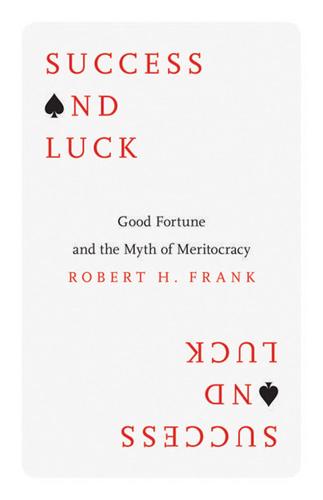
Success and Luck: Good Fortune and the Myth of Meritocracy
by
Robert H. Frank
Published 31 Mar 2016
With apologies to those I neglect to mention explicitly, I’d like to express my sincere gratitude to Peter Bloom, Summer Brown, Bruce Buchanan, CAU seminar participants, Philip Cook, Richard Dawkins, David DeSteno, Nick Epley, Alissa Fishbane, Chris Frank, David Frank, Hayden Frank, Jason Frank, Srinagesh Gavernini, Tom Gilovich, Piper Goodeve, Janet Greenfield, Jon Haidt, Ori Heffetz, Yuezhou Hou, Graham Kerslick, Kathi Mestayer, Dave Nussbaum, NYU Paduano Seminar participants, Sam Pizzigati, Dennis Regan, Russell Sage Foundation seminar participants, Kirsten Saracini, Eric Schoenberg, Barry Schwartz, Larry Seidman, Amit Singh, Rory Sutherland, David Sloan Wilson, Andrew Wylie, and Caitlin Zaloom for their advice and encouragement. They of course bear no responsibility for any remaining errors. I’m also grateful to Honor Jones and Kathleen Kageff for their skillful editorial assistance. And finally, I thank Peter Dougherty and Seth Ditchik at Princeton University Press for their enthusiastic support and, above all, for their enduring faith that books still matter. 1 WRITE WHAT YOU KNOW Writers are told to “write what you know,” and that’s one reason I began writing about luck several years ago.
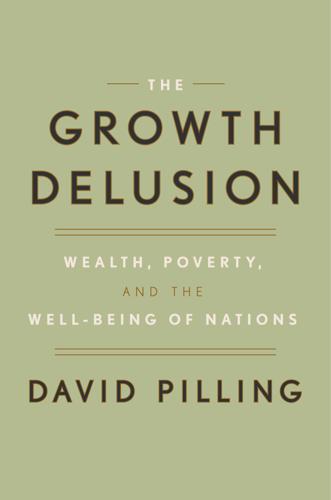
The Growth Delusion: Wealth, Poverty, and the Well-Being of Nations
by
David Pilling
Published 30 Jan 2018
See also David Pilling, “Lunch with the FT: Ha-Joon Chang,” Financial Times, November 29, 2013: www.ft.com. 10. Murad Ahmed, “Your Robot Doctor Will See You Now,” Financial Times, January 13, 2016: www.ft.com. 11. “Why the Japanese Economy Is Not Growing: Micro-barriers to Productivity Growth,” McKinsey Global Institute, July 2000. 12. This hilarious example is taken from Rory Sutherland, “Life Lessons from an Ad Man,” TED Talk, July 2009: www.ted.com. 13. From a telephone interview with the former head of the Bureau of Economic Analysis, Steve Landefeld, or Mr. GDP as I like to call him, February 2017. 14. Adam Sherwin, “Welsh Town Moves Offshore to Avoid Tax on Local Business,” Independent, November 10, 2015. 15.
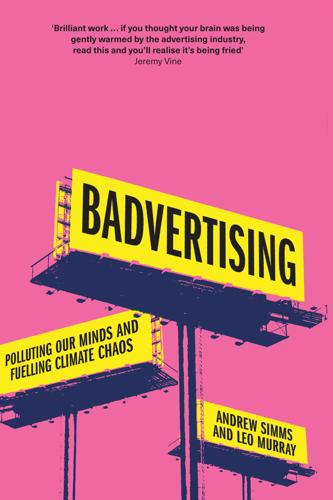
Badvertising
by
Andrew Simms
If this were not the case, the only possible explanations are either that you believe marketers are too ineffectual to make any difference, or you believe that marketing activities only affect people at the level of conscious argument. Neither of these possibilities appeals to me. I would rather be thought of as evil than useless. —Rory Sutherland, President of the Institute of Practitioners in Advertising, 2009 Even if ‘new’ is its favourite word, Advertising is not new. At its simplest it is a mechanism for selling us products and services, and inevitably some of those products – like tobacco – are bad for us. But it is now clear that advertising is not just trying to sell us products, which may or may not be good for us, it is selling us ideas that will end up making life impossible for billions of people around the world.
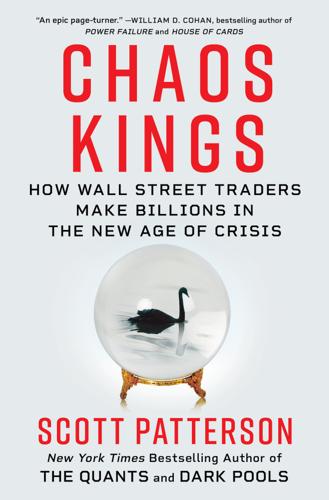
Chaos Kings: How Wall Street Traders Make Billions in the New Age of Crisis
by
Scott Patterson
Published 5 Jun 2023
It was the side of Taleb that bothered some of his friends the most. He saw Twitter as an intellectual gladiatorial battleground and engaged “enemies” like a wild-eyed prophet denouncing heresies and doling out ruthless sentences. Victims ranged from random nobodies to Nobel Prize winners. He’d taken to heart advice from a friend, Rory Sutherland—the outspoken vice chairman of ad agency Ogilvy UK who liked to quip that a flower is a weed with an advertising budget—who told Taleb that he advised CEOs to be rude and use foul language, since it made them seem more sincere and honest and signaled their freedom from constraining norms. The pugilistic diatribes and grade-school insults harmed Taleb’s reputation with friend and foe alike.
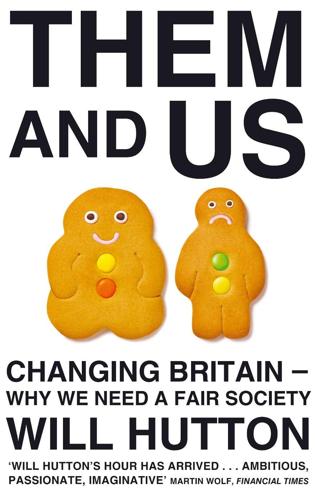
Them And Us: Politics, Greed And Inequality - Why We Need A Fair Society
by
Will Hutton
Published 30 Sep 2010
I have shown a number of people chapters in draft, and their feedback has been fantastically helpful and supportive. In particular I would like to thank Richard Layard, David Held, David Miliband, Alan Rusbridger, Paul Webster, Ruaridh Nicoll, Andrew Haldane, Helena Kennedy, Lindsay Mckie and Tim Horton for their comments and criticisms. Steve Gaskell, Ed Sweeney and Rory Sutherland also offered interesting and illuminating comments, as did Zamila Bunglawala, John Denham, Josie Cluer, Andy Westwood and Stuart White. David Held organised a seminar at the LSE with, Eva-Maria Nag, Paul Kelly, Hakan Seckinelgin and Tim Horton to discuss Chapters 2 and 3, which led to important redrafting.

Enlightenment Now: The Case for Reason, Science, Humanism, and Progress
by
Steven Pinker
Published 13 Feb 2018
And just think of all the plastic, metal, and paper that no longer go into the forty-odd consumer products that can be replaced by a single smartphone, including a telephone, answering machine, phone book, camera, camcorder, tape recorder, radio, alarm clock, calculator, dictionary, Rolodex, calendar, street maps, flashlight, fax, and compass—even a metronome, outdoor thermometer, and spirit level. Digital technology is also dematerializing the world by enabling the sharing economy, so that cars, tools, and bedrooms needn’t be made in huge numbers that sit around unused most of the time. The advertising analyst Rory Sutherland has noted that dematerialization is also being helped along by changes in the criteria of social status.37 The most expensive London real estate today would have seemed impossibly cramped to wealthy Victorians, but the city center is now more fashionable than the suburbs. Social media have encouraged younger people to show off their experiences rather than their cars and wardrobes, and hipsterization leads them to distinguish themselves by their tastes in beer, coffee, and music.